Management > QUESTIONS & ANSWERS > DEVRY UNIVERSITY, KELLER GRADUATE SCHOOL OF MANAGEMENT - BUSN 278FINALS2 CHAPTER 12 PLANNING FOR CAP (All)
DEVRY UNIVERSITY, KELLER GRADUATE SCHOOL OF MANAGEMENT - BUSN 278FINALS2 CHAPTER 12 PLANNING FOR CAPITAL INVESTMENTS. All Answers Provided
Document Content and Description Below
DEVRY UNIVERSITY, KELLER GRADUATE SCHOOL OF MANAGEMENT - BUSN 278FINALS2 CHAPTER 12 PLANNING FOR CAPITAL INVESTMENTS CHAPTER STUDY OBJECTIVES 1. Discuss the capital budgeting evaluation ... process, and explain what inputs are used in capital budgeting. 2. Describe the cash payback technique. 3. Explain the net present value method.. 4. Identify the challenges presented by intangible benefits in capital budgeting. 5. Describe the profitability index. 6. Indicate the benefits of performing a post-audit. 7. Explain the internal rate of return method. 8. Describe the annual rate of return method. TRUE-FALSE STATEMENTS 1. Capital budgeting decisions usually involve large investments and often have a significant impact on a company's future profitability. 2. The capital budgeting committee ultimately approves the capital expenditure budget for the year. 3. For purposes of capital budgeting, estimated cash inflows and outflows are preferred for inputs into the capital budgeting decision tools. 4. The cash payback technique is a quick way to calculate a project's net present value. 5. The cash payback period is computed by dividing the cost of the capital investment by the annual cash inflow. 6. The cash payback method is frequently used as a screening tool but it does not take into consideration the profitability of a project. 7. The cost of capital is a weighted average of the rates paid on borrowed funds, as well as on funds provided by investors in the company's stock. 8. Using the net present value method, a net present value of zero indicates that the project would not be acceptable. 9. The net present value method can only be used in capital budgeting if the expected cash flows from a project are an equal amount each year. 10. By ignoring intangible benefits, capital budgeting techniques might incorrectly eliminate projects that could be financially beneficial to the company. 11. To avoid accepting projects that actually should be rejected, a company should ignore intangible benefits in calculating net present value. 12. One way of incorporating intangible benefits into the capital budgeting decision is to project conservative estimates of the value of the intangible benefits and include them in the NPV calculation. 13. The profitability index is calculated by dividing the total cash flows by the initial investment. 14. The profitability index allows comparison of the relative desirability of projects that require differing initial investments. 15. Sensitivity analysis uses a number of outcome estimates to get a sense of the variability among potential returns. 16. A well-run organization should perform an evaluation, called a post-audit, of its investment projects before their completion. 17. Post-audits create an incentive for managers to make accurate estimates, since managers know that their results will be evaluated. 18. A post-audit is an evaluation of how well a project's actual performance matches the projections made when the project was proposed. 19. The internal rate of return method is, like the NPV method, a discounted cash flow technique. 20. The interest yield of a project is a rate that will cause the present value of the proposed capital expenditure to equal the present value of the expected annual cash inflows. 21. Using the internal rate of return method, a project is rejected when the rate of return is greater than or equal to the required rate of return. 22. Using the annual rate of return method, a project is acceptable if its rate of return is greater than management's minimum rate of return. 23. The annual rate of return method requires dividing a project's annual cash inflows by the economic life of the project. 24. A major advantage of the annual rate of return method is that it considers the time value of money. 25. An advantage of the annual rate of return method is that it relies on accrual accounting numbers rather than actual cash flows. MULTIPLE CHOICE QUESTIONS 26. The capital budget for the year is approved by a company's a. board of directors. b. capital budgeting committee. c. officers. d. stockholders. 27. All of the following are involved in the capital budgeting evaluation process except a company's a. board of directors. b. capital budgeting committee. c. officers. d. stockholders. 28. Most of the capital budgeting methods use a. accrual accounting numbers. b. cash flow numbers. c. net income. d. accrual accounting revenues. 29. The first step in the capital budgeting evaluation process is to a. request proposals for projects. b. screen proposals by a capital budgeting committee. c. determine which projects are worthy of funding. d. approve the capital budget. 30. The capital budgeting decision depends in part on the a. availability of funds. b. relationships among proposed projects. c. risk associated with a particular project. d. all of these. 31. Capital budgeting is the process a. used in sell or process further decisions. b. of determining how much capital stock to issue. c. of making capital expenditure decisions. d. of eliminating unprofitable product lines. 32. If an asset costs $70,000 and is expected to have a $10,000 salvage value at the end of its ten-year life, and generates annual net cash inflows of $10,000 each year, the cash payback period is a. 8 years. b. 7 years. c. 6 years. d. 5 years. 33. If a payback period for a project is greater than its expected useful life, the a. project will always be profitable. b. entire initial investment will not be recovered. c. project would only be acceptable if the company's cost of capital was low. d. project's return will always exceed the company's cost of capital. 34. The cash payback technique a. should be used as a final screening tool. b. can be the only basis for the capital budgeting decision. c. is relatively easy to compute and understand. d. considers the expected profitability of a project. 35. The cash payback period is computed by dividing the cost of the capital investment by the a. annual net income. b. net annual cash inflow. c. present value of the cash inflow. d. present value of the net income. 36. When using the cash payback technique, the payback period is expressed in terms of a. a percent. b. dollars. c. years. d. months. 37. A disadvantage of the cash payback technique is that it a. ignores obsolescence factors. b. ignores the cost of an investment. c. is complicated to use. d. ignores the time value of money. 38. Bark Company is considering buying a machine for $120,000 with an estimated life of ten years and no salvage value. The straight-line method of depreciation will be used. The machine is expected to generate net income of $8,000 each year. The cash payback period on this investment is a. 15 years. b. 10 years. c. 6 years. d. 3 years. 39. The discount rate is referred to by all of the following alternative names except the a. cost of capital. b. cutoff rate. c. hurdle rate. d. required rate of return. 40. The rate that a company must pay to obtain funds from creditors and stockholders is known as the a. hurdle rate. b. cost of capital. c. cutoff rate. d. all of these. 41. The higher the risk element in a project, the a. more attractive the investment. b. higher the net present value. c. higher the cost of capital. d. higher the discount rate. 42. If a company's required rate of return is 10% and, in using the net present value method, a project's net present value is zero, this indicates that the a. project's rate of return exceeds 10%. b. project's rate of return is less than the minimum rate required. c. project earns a rate of return of 10%. d. project earns a rate of return of 0%. 43. Using the profitability index method, the present value of cash inflows for Project Flower is $88,000 and the present value of cash inflows of Project Plant is $48,000. If Project Flower and Project Plant require initial investments of $90,000 and $40,000, respectively, and have the same useful life, the project that should be accepted is a. Project Flower. b. Project Plant. c. Either project may be accepted. d. Neither project should be accepted. 44. The primary capital budgeting method that uses discounted cash flow techniques is the a. net present value method. b. cash payback technique. c. annual rate of return method. d. profitability index method. 45. When the annual cash flows from an investment are unequal, the appropriate table to use is the a. future value of 1 table. b. future value of annuity table. c. present value of 1 table. d. present value of annuity table. 46. A company's cost of capital refers to the a. rate the company must pay to obtain funds from creditors and stockholders. b. total cost of a capital project. c. cost of printing and registering common stock shares. d. rate of return earned on common stock. 47. Intangible benefits in capital budgeting would include all of the following except increased a. product quality. b. employee loyalty. c. salvage value. d. product safety. 48. Intangible benefits in capital budgeting a. should be ignored because they are difficult to determine. b. include increased quality or employee loyalty. c. are not considered because they are usually not relevant to the decision. d. have a rate of return in excess of the company’s cost of capital. 49. To avoid rejecting projects that actually should be accepted, 1. intangible benefits should be ignored. 2. conservative estimates of the intangible benefits' value should be incorporated into the NPV calculation. 3. calculate net present value ignoring intangible benefits and then, if the NPV is negative, estimate whether the intangible benefits are worth at least the amount of the negative NPV. a. 1 b. 2 c. 3 d. both 2 and 3 are correct. 50. All of the following statements about intangible benefits in capital budgeting are correct except that they a. include increased quality and employee loyalty. b. are difficult to quantify. c. are often ignored in capital budgeting decisions. d. cannot be incorporated into the NPV calculation. 51. In evaluating high-tech projects, a. only tangible benefits should be considered. b. only intangible benefits should be considered. c. both tangible and intangible benefits should be considered. d. neither tangible nor intangible benefits should be considered. 52. Using a number of outcome estimates to get a sense of the variability among potential returns is a. financial analysis. b. post-audit analysis. c. sensitivity analysis. d. outcome analysis. 53. If a company's required rate of return is 9%, and in using the profitability index method, a project's index is greater than 1, this indicates that the project's rate of return is a. equal to 9%. b. greater than 9%. c. less than 9%. d. unacceptable for investment purposes. 54. The profitability index is computed by dividing the a. total cash flows by the initial investment. b. present value of cash flows by the initial investment. c. initial investment by the total cash flows. d. initial investment by the present value of cash flows. 55. The capital budgeting method that takes into account both the size of the original investment and the discounted cash flows is the a. cash payback method. b. internal rate of return method. c. net present value method. d. profitability index. 56. The profitability index a. does not take into account the discounted cash flows. b. is calculated by dividing total cash flows by the initial investment. c. allows comparison of the relative desirability of projects that require differing initial investments. d. will never be greater than 1. 57. The capital budgeting method that allows comparison of the relative desirability of projects that require differing initial investments is the a. cash payback method. b. internal rate of return method. c. net present value method. d. profitability index. 58. The following information is available for a potential investment for Panda Company: Initial investment $40,000 Net annual cash inflow 10,000 Net present value 18,112 Salvage value 5,000 Useful life 10 yrs. The potential investment’s profitability index is a. 4.00 b. 2.85 c. 2.50 d. 1.45 59. An approach that uses a number of outcome estimates to get a sense of the variability among potential returns is a. the discounted cash flow technique. b. the net present value method. c. risk analysis. d. sensitivity analysis. 60. Post-audits of capital projects a. are usually foolproof. b. are done using different evaluation techniques than were used in making the original capital budgeting decision. c. provide a formal mechanism by which the company can determine whether existing projects should be supported or terminated. d. all of these. 61. A post-audit should be performed using a. a different evaluation technique than that used in making the original decision. b. the same evaluation technique used in making the original decision. c. estimated amounts instead of actual figures. d. an independent CPA. 62. A thorough evaluation of how well a project's actual performance matches the projections made when the project was proposed is called a a. pre-audit. b. post-audit. c. risk analysis. d. sensitivity analysis. 63. Performing a post-audit is important because a. managers will be more likely to submit reasonable data when they make investment proposals if they know their estimates will be compared to actual results. b. it provides a formal mechanism by which the company can determine whether existing projects should be terminated. c. it improves the development of future investment proposals because managers improve their estimation techniques by evaluating their past successes and failures. d. all of these. 64. A capital budgeting method that takes into consideration the time value of money is the a. annual rate of return method. b. return on stockholders' equity method. c. cash payback technique. d. internal rate of return method. 65. The internal rate of return is the interest rate that results in a a. positive NPV. b. negative NPV. c. zero NPV. d. positive or negative NPV. 66. In using the internal rate of return method, the internal rate of return factor was 4.0 and the equal annual cash inflows were $12,000. The initial investment in the project must have been a. $12,000. b. $3,000. c. $48,000. d. $24,000. 67. The capital budgeting technique that finds the interest yield of the potential investment is the a. annual rate of return method. b. internal rate of return method. c. net present value method. d. profitability index method. 68. All of the following statements about the internal rate of return method are correct except that it a. recognizes the time value of money. b. is widely used in practice. c. is easy to interpret. d. can be used only when the cash inflows are equal. Use the following table for questions 69–72. Present Value of an Annuity of 1 Periods 8% 9% 10% 1 .926 .917 .909 2 1.783 1.759 1.736 3 2.577 2.531 2.487 69. A company has a minimum required rate of return of 9% and is considering investing in a project that costs $140,000 and is expected to generate cash inflows of $56,000 at the end of each year for three years. The net present value of this project is a. $141,736. b. $28,000. c. $14,174. d. $1,736. 70. A company has a minimum required rate of return of 9% and is considering investing in a project that costs $50,000 and is expected to generate cash inflows of $20,000 at the end of each year for three years. The profitability index for this project is a. .99. b. 1.00. c. 1.01. d. 1.20. 71. A company has a minimum required rate of return of 8% and is considering investing in a project that costs $68,337 and is expected to generate cash inflows of $27,000 each year for three years. The approximate internal rate of return on this project is a. 8%. b. 9%. c. 10%. d. less than the required 8%. 72. A company has a minimum required rate of return of 10% and is considering investing in a project that requires an investment of $70,000 and is expected to generate cash inflows of $30,000 at the end of each year for 3 years. The present value of future cash inflows for this project is a. $70,000. b. $74,610. c. $82,070. d. $4,610 Use the following information for questions 73–76. Carr Company is considering two capital investment proposals. Estimates regarding each project are provided below: Project Soup Project Nuts Initial investment $400,000 $600,000 Annual net income 20,000 42,000 Net annual cash inflow 100,000 142,000 Estimated useful life 5 years 6 years Salvage value -0- -0- The company requires a 10% rate of return on all new investments. Present Value of an Annuity of 1 Periods 9% 10% 11% 12% 5 3.890 3.791 3.696 3.605 6 4.486 4.355 4.231 4.111 73. The cash payback period for Project Soup is a. 20 years. b. 10 years. c. 5 years. d. 4 years. 74. The net present value for Project Nuts is a. $618,410. b. $182,912. c. $100,000. d. $18,410. 75. The annual rate of return for Project Soup is a. 5%. b. 10%. c. 25%. d. 50%. 76. The internal rate of return for Project Nuts is approximately a. 10%. b. 11%. c. 12%. d. 9%. Use the following information for questions 77 and 78. A company is considering purchasing factory equipment that costs $320,000 and is estimated to have no salvage value at the end of its 8-year useful life. If the equipment is purchased, annual revenues are expected to be $90,000 and annual operating expenses exclusive of depreciation expense are expected to be $38,000. The straight-line method of depreciation would be used. 77. If the equipment is purchased, the annual rate of return expected on this equipment is a. 32.5%. b. 3.8%. c. 7.5%. d. 16.3%. 78. The cash payback period on the equipment is a. 13.3 years. b. 8.0 years. c. 6.2 years. d. 3.1 years. 79. The capital budgeting technique that indicates the profitability of a capital expenditure is the a. profitability index method. b. net present value method. c. internal rate of return method. d. annual rate of return method. 80. The annual rate of return method is based on a. accounting data. b. the time value of money data. c. market values. d. cash flow data. 81. Disadvantages of the annual rate of return method include all of the following except that a. it relies on accrual accounting numbers instead of actual cash flows. b. it does not consider the time value of money. c. no consideration is given as to when the cash inflows occur. d. management is unfamiliar with the information used in the computation. 82. A company projects an increase in net income of $60,000 each year for the next five years if it invests $300,000 in new equipment. The equipment has a five-year life and an estimated salvage value of $100,000. What is the annual rate of return on this investment? a. 20% b. 30% c. 25% d. 50% 83. Colaw Company is considering buying equipment for $80,000 with a useful life of five years and an estimated salvage value of $4,000. If annual expected income is $7,000, the denominator in computing the annual rate of return is a. $80,000. b. $40,000. c. $42,000. d. $84,000. 84. The annual rate of return is computed by dividing expected annual a. cash inflows by average investment. b. net income by average investment. c. cash inflows by original investment. d. net income by original investment. 85. All of the following statements about the annual rate of return method are correct except that it a. indicates the profitability of a capital expenditure. b. ignores the salvage value of an investment. c. does not consider the time value of money. d. compares the annual rate of return to management’s minimum rate of return. 86. Rod Co. is planning on investing in a new 2-year project, Project Jelly. Project Jelly is expected to produce cash flows of $100,000 and $160,000 in each of the 2 years, respectively. Rod requires an internal rate of return of 15%. What is the maximum amount that Rod should invest immediately in Project Jelly? Present Value of 1 Future Value of 1 Period 15% Period 15% 1 .870 1 1.150 2 .756 2 1.323 a. $163,340 b. $207,960 c. $260,000 d. $326,680 87. Vault Company wants to purchase an asset with a 3-year useful life, which is expected to produce cash inflows of $15,000 each year for two years, and $10,000 in year 3. Vault has a 14% cost of capital, and uses the following factors. What is the present value of these future cash flows? Present Value of 1 Period 14% 1 .88 2 .77 3 .67 a. $29,800 b. $30,400 c. $31,450 d. $34,750 88. Doris Co. is considering purchasing a new machine which will cost $200,000, but which will decrease costs each year by $40,000. The useful life of the machine is 10 years. The machine would be depreciated straight-line with no residual value over its useful life at the rate of $20,000/year. The payback period is a. 4.0 years b. 4.5 years c. 5.0 years d. 10.0 years 89. Tammy Co. is considering purchasing a machine that will produce annual savings of $24,600 at the end of the year. Tammy requires a 12% rate of return and the asset has a 5-year useful life. How much should Tammy agree to pay for this machine? Present Value of Annuity of 1 Present Value of 1 Period 12% Period 12% 5 3.605 5 .567 a. $43,386 b. $88,683 c. $123,000 d. $69,741 90. Mystery Co. is considering purchasing a new piece of equipment that will cost $600,000. The equipment has an estimated useful life of 8 years and no salvage value. The equipment will produce cash inflows of $225,000 per year and net income of $90,000 per year. Mystery requires a 10% rate of return. What is the payback period for this equipment? a. 8.0 years b. 4.44 years c. 2.67 years d. 6.67 years 91. Cleaners, Inc. is considering purchasing equipment costing $30,000 with a 6-year useful life. The equipment will provide cost savings of $7,300 and will be depreciated straight-line over its useful life with no salvage value. Cleaners, Inc. requires a 10% rate of return. What is the approximate internal rate of return for this investment? Present Value of an Annuity of 1 Period 8% 9% 10% 11% 12% 15% 6 4.623 4.486 4.355 4.231 4.111 3.784 a. 9% b. 10% c. 11% d. 12% 92. Cleaners, Inc. is considering purchasing equipment costing $30,000 with a 6-year useful life. The equipment will provide cost savings of $7,300 and will be depreciated straight-line over its useful life with no salvage value. Cleaners, Inc. requires a 10% rate of return. What is the approximate net present value of this investment? Present Value of an Annuity of 1 Period 8% 9% 10% 11% 12% 15% 6 4.623 4.486 4.355 4.231 4.111 3.784 a. $13,800 b. $1,792 c. $886 d. $2,748 93. Cleaners, Inc. is considering purchasing equipment costing $30,000 with a 6-year useful life. The equipment will provide cost savings of $7,300 and will be depreciated straight-line over its useful life with no salvage value. Cleaners, Inc. requires a 10% rate of return. What is the approximate profitability index associated with this equipment? Present Value of an Annuity of 1 Period 8% 9% 10% 11% 12% 15% 6 4.623 4.486 4.355 4.231 4.111 3.784 a. 1.23 b. 1.03 c. 1.06 d. .73 Answers to Multiple Choice Questions BRIEF EXERCISES Ex. 94 Diamond Co. is considering investing in new equipment that will cost $900,000 with a 10-year useful life. The new equipment is expected to produce annual net income of $30,000 over its useful life. Depreciation expense, using the straight-line rate, is $90,000 per year. Instructions Compute the payback period. Solution 94 (5 min.) $900,000 ÷ ($30,000 + $90,000) = 7.5 years Ex. 95 Madeline Company is proposing to spend $140,000 to purchase a machine that will provide annual cash flows of $25,000. The appropriate present value factor for 10 periods is 5.65. Instructions Compute the proposed investment’s net present value, and indicate whether the investment should be made by Madeline Company. Ex. 96 LakeFront Co. is considering investing in a new dock that will cost $280,000. The company expects to use the dock for 5 years, after which it will be sold for $150,000 at that time. LakeFront anticipates cash flows of $50,000 resulting from the new dock and the company’s borrowing rate is 8%, while its cost of capital is 10%. Instructions Calculate the net present value of the dock and indicate whether LakeFront should make the investment. Ex. 97 Mobil Co. has hired a consultant to propose a way to increase the company’s revenues. The consultant has evaluated two mutually exclusive projects with the following information provided for each project: Project Turtle Project Snake Capital investment $790,000 $440,000 Annual cash flows 140,000 80,000 Estimated useful life 10 years 10 years Mobil Co. uses a discount rate of 9% to evaluate both projects. Instructions (a) Calculate the net present value of both projects. (b) Calculate the profitability index for each project. (c) Which project should Mobil accept? Ex. 98 An investment costing $90,000 is being contemplated by Mint Co. The investment will have a life of 8 years with no salvage value and will produce annual cash flows of $16,870. Instructions What is the approximate internal rate of return associated with this investment? Ex. 99 Salt Co. is considering investing in a new facility to extract and produce salt. The facility will increase revenues by $240,000, but will also increase annual expenses by $160,000. The facility will cost $980,000 to build, but will have a $20,000 salvage value at the end of its 20-year useful life. Instructions Calculate the annual rate of return on this facility. EXERCISES Ex. 100 Corn Doggy, Inc. produces and sells corn dogs. The corn dogs are made by hand. Austin Beagle, production manager, is considering purchasing a machine that will make the corn dogs. Austin has shopped for machines and found that the machine he wants will cost $262,000. In addition, Austin estimates that the new machine will increase the company’s annual net cash inflows by $42,400. The machine will have a 12-year useful life and no salvage value. Instructions (a) Calculate the cash payback period. (b) Calculate the machine’s internal rate of return. (c) Calculate the machine’s net present value using a discount rate of 10%. (d) Assuming Corn Doggy Inc.’s cost of capital is 10%, is the investment acceptable? Why or why not? Ex. 101 Top Growth Farms, a farming cooperative, is considering purchasing an tractor for $475,000. The machine has a 10-year life and an estimated salvage value of $27,500. Delivery costs and set-up charges will be $12,100 and $400, respectively. Top Growth uses straight-line depreciation. Top Growth estimates that the tractor will be used five times a week with the average charge to the individual farmers of $400. Gas is $25 for each use of the tractor. The present value of an annuity of 1 for 10 years at 9% is 6.418. Instructions For the new tractor, compute the: (a) cash payback period. (b) net present value. (c) annual rate of return. $257,500 Ex. 102 Mimi Company is considering a capital investment of $240,000 in new equipment. The equipment is expected to have a 5-year useful life with no salvage value. Depreciation is computed by the straight-line method. During the life of the investment, annual net income and cash inflows are expected to be $30,000 and $78,000, respectively. Mimi's minimum required rate of return is 10%. The present value of 1 for 5 periods at 10% is .621 and the present value of an annuity of 1 for 5 periods at 10% is 3.791. Instructions Compute each of the following: (a) cash payback period. (b) net present value. (c) annual rate of return. Ex. 103 Savanna Company is considering two capital investment proposals. Relevant data on each project are as follows: Project Red Project Blue Capital investment $400,000 $560,000 Annual net income 30,000 50,000 Estimated useful life 8 years 8 years Depreciation is computed by the straight-line method with no salvage value. Savanna requires an 8% rate of return on all new investments. The present value of 1 for 8 periods at 8% is .540 and the present value of an annuity of 1 for 8 periods is 5.747. Instructions (a) Compute the cash payback period for each project. (b) Compute the net present value for each project. (c) Compute the annual rate of return for each project. (d) Which project should Savanna select? Ex. 104 Tom Bat became a baseball enthusiast at a very early age. All of his baseball experience has provided him valuable knowledge of the sport, and he is thinking about going into the batting cage business. He estimates the construction of a state-of-the-art facility and the purchase of necessary equipment will cost $630,000. Both the facility and the equipment will be depreciated over 12 years using the straight-line method and are expected to have zero salvage values. His required rate of return is 13% (present value factor of 5.9176). Estimated annual net income and cash flows are as follows: Revenue $329,000 Less: Utility cost 40,000 Supplies 8,000 Labor 126,000 Depreciation 52,500 Other 38,500 265,000 Net income $64,000 Instructions For this investment, calculate: (a) The net present value. (b) The internal rate of return. (c) The cash payback period. Ex. 105 Vista Company is considering two new projects, each requiring an equipment investment of $90,000. Each project will last for three years and produce the following cash inflows: Year Cool Hot 1 $38,000 $42,000 2 42,000 42,000 3 48,000 42,000 $128,000 $126,000 The equipment will have no salvage value at the end of its three-year life. Vista Company uses straight-line depreciation, and requires a minimum rate of return of 12%. Present value data are as follows: Present Value of 1 Present Value of an Annuity of 1 Period 12% Period 12% 1 .893 1 .893 2 .797 2 1.690 3 .712 3 2.402 Instructions (a) Compute the net present value of each project. (b) Compute the profitability index of each project. (c) Which project should be selected? Why? Ex. 106 Santana Company is considering investing in a project that will cost $73,000 and have no salvage value at the end of its 5-year life. It is estimated that the project will generate annual cash inflows of $20,000 each year. The company requires a 10% rate of return and uses the following compound interest table: Present Value of an Annuity of 1 Period 6% 8% 9% 10% 11% 12% 15% 5 4.212 3.993 3.890 3.791 3.696 3.605 3.352 Instructions (a) Compute (1) the net present value and (2) the profitability index of the project. (b) Compute the internal rate of return on this project. (c) Should Santana invest in this project? Instructions (a) Compute the (1) net present value, (2) profitability index, and (3) internal rate of return for each machine. (b) Which machine should be purchased? Ex. 108 Yappy Company is considering a capital investment of $320,000 in additional equipment. The new equipment is expected to have a useful life of 8 years with no salvage value. Depreciation is computed by the straight-line method. During the life of the investment, annual net income and cash inflows are expected to be $22,000 and $62,000, respectively. Yappy requires a 9% return on all new investments. Present Value of an Annuity of 1 Period 8% 9% 10% 11% 12% 15% 8 5.747 5.535 5.335 5.146 4.968 4.487 Instructions (a) Compute each of the following: 1. Cash payback period. 2. Net present value. 3. Profitability index. 4 Internal rate of return. 5. Annual rate of return. (b) Indicate whether the investment should be accepted or rejected. Ex. 109 Platoon Company is performing a post-audit of a project that was estimated to cost $300,000, have a useful life of 6 years with a zero salvage value, and result in net cash inflows of $70,000 per year. After the investment has been in operation for a year, revised figures indicate that it actually cost $340,000, will have a 9-year useful life, and will produce net cash inflows of $58,000. The present value of an annuity of 1 for 6 years at 10% is 4.355 and for 9 years is 5.759. Instructions Determine whether the project should have been accepted based on (a) the original estimates and then on (b) the actual amounts. Ex. 110 Sophie’s Pet Shop is considering the purchase of a new delivery van. Sophie Smith, owner of the shop, has compiled the following estimates in trying to determine whether the delivery van should be purchased: Cost of the van $25,000 Annual net cash flows 4,300 Salvage value 3,000 Estimated useful life 8 years Cost of capital 10% Present value of an annuity of 1 5.335 Present value of 1 .467 Sophie's assistant manager is trying to convince Sophie that the van has other benefits that she hasn't considered in the initial estimates. These additional benefits, including the free advertising the store's name painted on the van's doors will provide, are expected to increase net cash flows by $500 each year. Ex. 110 (cont.) Instructions (a) Calculate the net present value of the van, based on the initial estimates. Should the van be purchased? (b) Calculate the net present value, incorporating the additional benefits suggested by the assistant manager. Should the van be purchased? (c) Determine how much the additional benefits would have to be worth in order for the van to be purchased. Ex. 111 Schilling Corp. is thinking about opening a baseball camp in Florida. In order to start the camp, the company would need to purchase land, build five baseball fields, and a dormitory-type sleeping and dining facility to house 100 players. Each year the camp would be run for 10 sessions of 1 week each. The company would hire college baseball players as coaches. The camp attendees would be baseball players age 12-18. Property values in Florida have enjoyed a steady increase in value. It is expected that after using the facility for 20 years, Schilling can sell the property for more than it was originally purchased for. The following amounts have been estimated: Cost of land $ 600,000 Cost to build dorm and dining facility 2,100,000 Annual cash inflows assuming 100 players and 10 weeks 2,520,000 Annual cash outflows 2,250,000 Estimated useful life 20 years Salvage value 3,900,000 Discount rate 10% Present value of an annuity of 1 8.514 Present value of 1 .149 Ex. 111 (cont.) Instructions (a) Calculate the net present value of the project. (b) To gauge the sensitivity of the project to these estimates, assume that if only 80 campers attend each week, revenues will be $2,085,000 and expenses will be $1,875,000. What is the net present value using these alternative estimates? Discuss your findings. (c) Assuming the original facts, what is the net present value if the project is actually riskier than first assumed, and a 12% discount rate is more appropriate? The present value of 1 at 12% is .104 and the present value of an annuity of 1 is 7.469. COMPLETION STATEMENTS 112. For purposes of capital budgeting, estimated ____________ and outflows are preferred for inputs into the capital budgeting decision tools. 113. The technique which identifies the time period required to recover the cost of the investment is called the ________________ method. 114. The two discounted cash flow techniques used in capital budgeting are (1) the _______________________ method and (2) the ______________________ method. 115. Under the net present value method, the interest rate to be used in discounting the future cash inflows is the ________________. 116. In using the net present value approach, a project is acceptable if the project's net present value is ____________ or_______________. 117. A project’s ________________, such as increased quality or safety, are often incorrectly ignored in capital budgeting decisions. 118. The _______________ is a method of comparing alternative projects that takes into account both the size of the investment and its discounted future cash flows. 119. A well-run organization should perform an evaluation, called a _____________, of its investment projects after their completion. 120. The internal rate of return method differs from the net present value method in that it results in finding the ___________________ of the potential investment. 121. A major limitation of the annual rate of return approach is that it does not consider the _______________ of money. MATCHING 122. Match the items below by entering the appropriate code letter in the space provided. A. Profitability index E. Annual rate of return method B. Internal rate of return method F. Cash payback technique C. Discounted cash flow techniques G. Cost of capital D. Capital budgeting H. Net present value method ____ 1. A capital budgeting technique that identifies the time period required to recover the cost of a capital investment from the annual cash inflow produced by the investment. ____ 2. Capital budgeting techniques that consider both the estimated total cash inflows from the investment and the time value of money. ____ 3. A method used in capital budgeting in which cash inflows are discounted to their present value and then compared to the capital outlay required by the capital investment. ____ 4. A method of comparing alternative projects that take into account both the size of the investment and its discounted cash flows. ____ 5. A method used in capital budgeting that results in finding the interest yield of the potential investment. ____ 6. The average rate of return that the firm must pay to obtain borrowed and equity funds. ____ 7. The determination of the profitability of a capital expenditure by dividing expected annual net income by the average investment. ____ 8. The process of making capital expenditure decisions in business. SHORT-ANSWER ESSAY QUESTIONS S-A E 123 Management uses several capital budgeting methods in evaluating projects for possible investment. Identify those methods that are more desirable from a conceptual standpoint, and briefly explain what features these methods have that make them more desirable than other methods. Also identify the least desirable method and explain its major weaknesses. S-A E 124 (Ethics) Sam Stanton is on the capital budgeting committee for his company, Canton Tile. Ed Rhodes is an engineer for the firm. Ed expresses his disappointment to Sam that a project that was given to him to review before submission looks extremely good on paper. "I really hoped that the cost projections wouldn't pan out," he tells his friend. "The technology used in this is pie in the sky kind of stuff. There are a hundred things that could go wrong. But the figures are very convincing. I haven't sent it on yet, though I probably should." "You can keep it if it's really that bad," assures Sam. "Anyway, you can probably get it shot out of the water pretty easily, and not have the guy who submitted it mad at you for not turning it in. Just fix the numbers. If you figure, for instance, that a cost is only 50% likely to be that low, then double it. We do it all the time, informally. Best of all, the rank and file don't get to come to those sessions. Your engineering genius need never know. He'll just think someone else's project was even better than his." Required: 1. Who are the stakeholders in this situation? 2. Is it ethical to adjust the figures to compensate for risk? Explain. 3. Is it ethical to change the proposal before submitting it? Explain. Solution 124 1. The stakeholders include: Ed Rhodes Canton Tile the engineer who submitted the proposal. 2. It is ethical, in general, to adjust projections to compensate for risk. However, it should be clearly stated that the projections have been adjusted for risk, and the method used should be available for review. Otherwise, the entire selection process is undermined, and it becomes entirely subjective. S-A E 125 (Communication) You are the general accountant for Word Systems, Inc., a typing service based in Los Angeles, California. The company has decided to upgrade its equipment. It currently has a widely used version of a word processing program. The company wishes to invest in more up-to-date software and to improve its printing capabilities. Two options have emerged. Option #1 is for the company to keep its existing computer system, and upgrade its word processing program. The memory of each individual work station would be enhanced, and a larger, more efficient printer would be used. Better telecommunications equipment would allow for the electronic transmission of some documents as well. Option #2 would be for the company to invest in an entirely different computer system. The software for this system is extremely impressive, and it comes with individual laser printers. However, the company is not well known, and the software does not connect well with well-known software. The net present value information for these options follows: Option #1 Option #2 Initial Investment ($95,000) ($270,000) Returns Year 1 55,000 90,000 Year 2 30,000 90,000 Year 3 10,000 90,000 Net present value 0 0 Required: Prepare a brief report for management in which you make a recommendation for one system or the other, using the information given. [Show More]
Last updated: 1 year ago
Preview 1 out of 35 pages
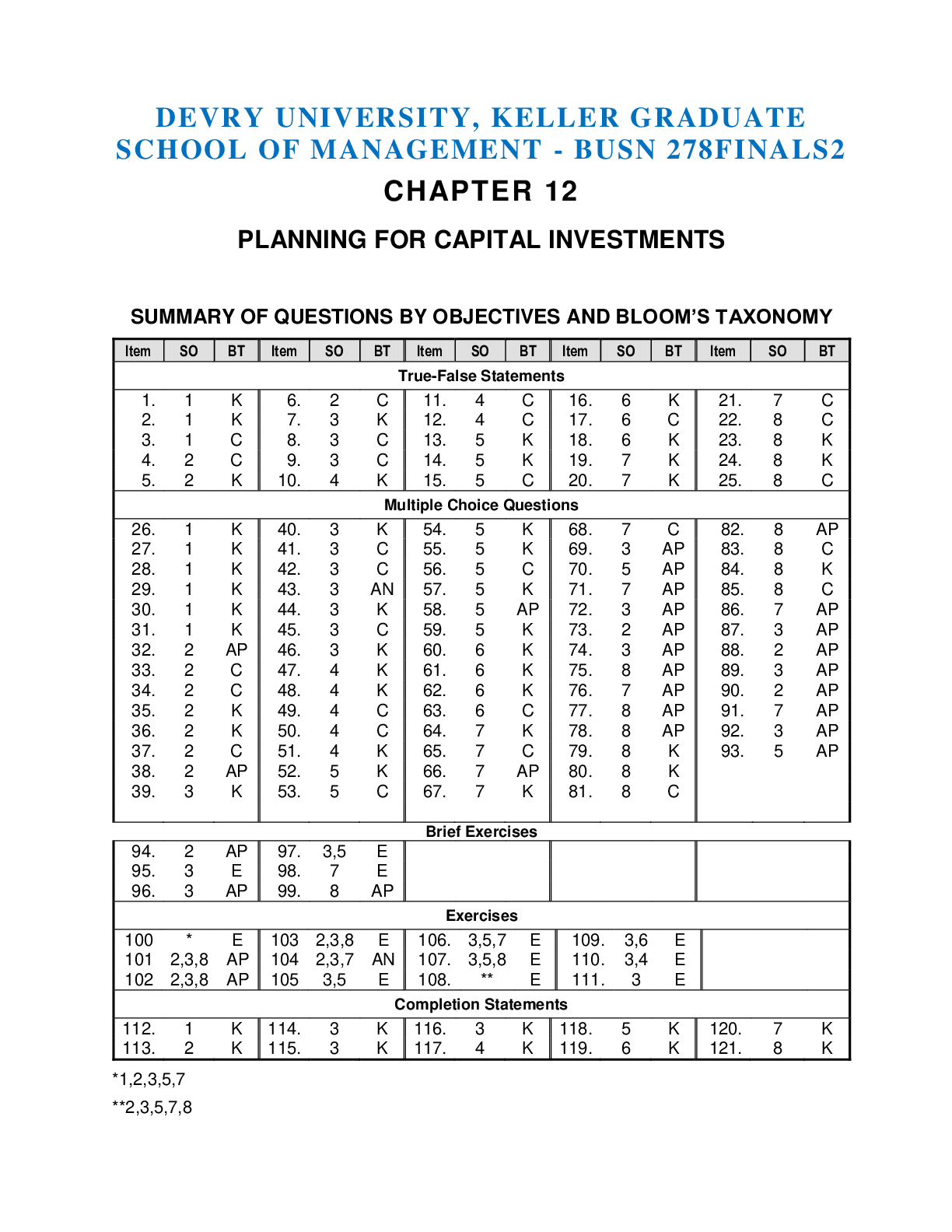
Reviews( 0 )
Document information
Connected school, study & course
About the document
Uploaded On
May 18, 2020
Number of pages
35
Written in
Additional information
This document has been written for:
Uploaded
May 18, 2020
Downloads
0
Views
103















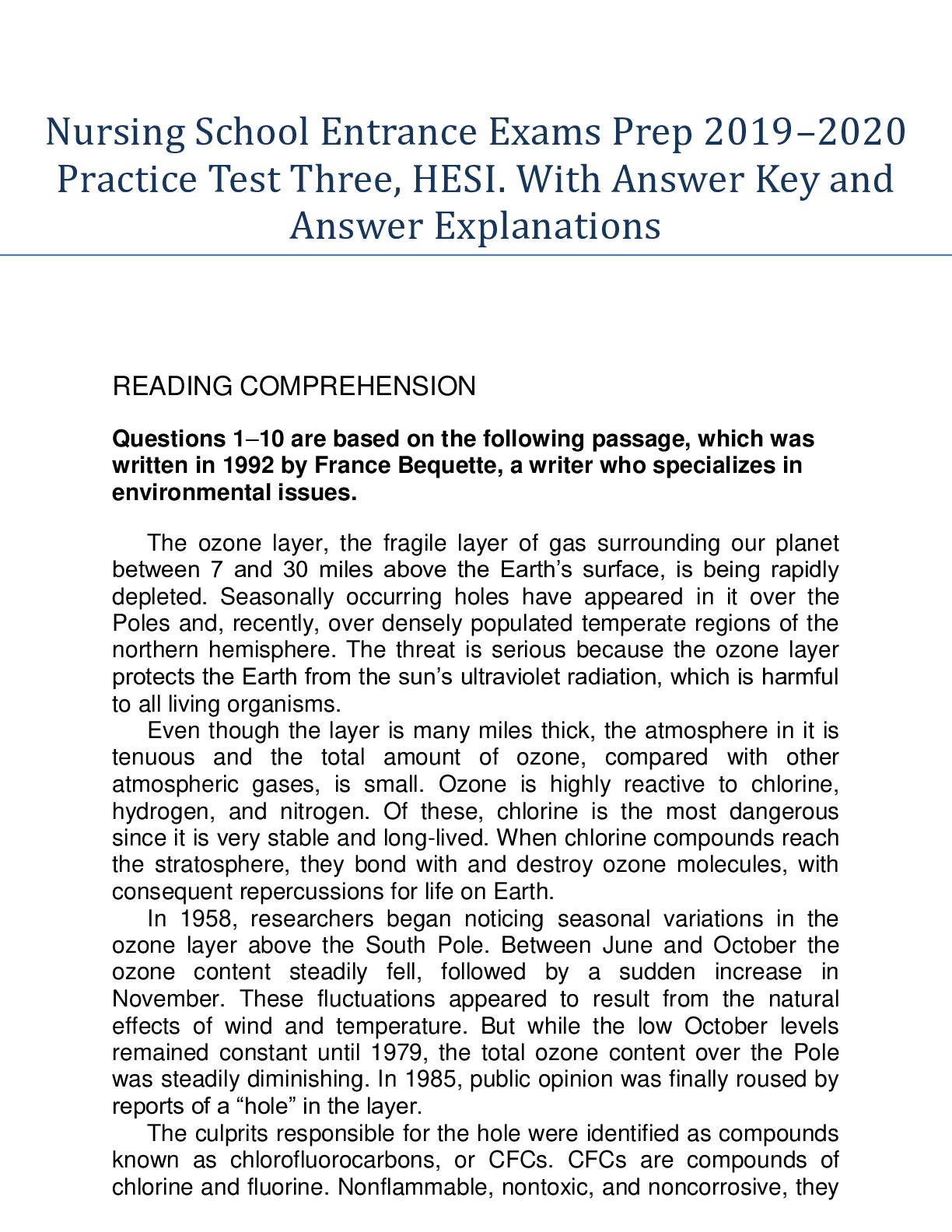

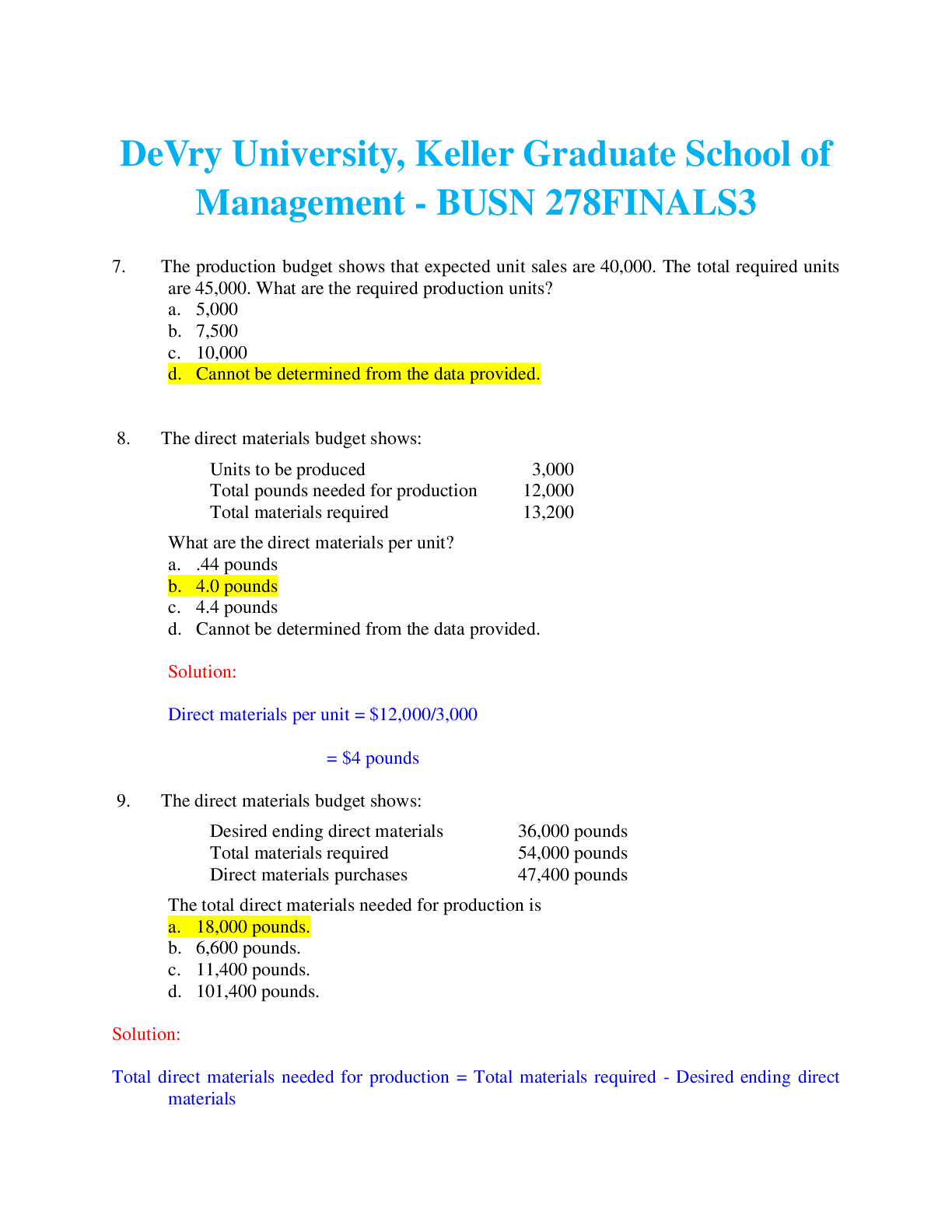
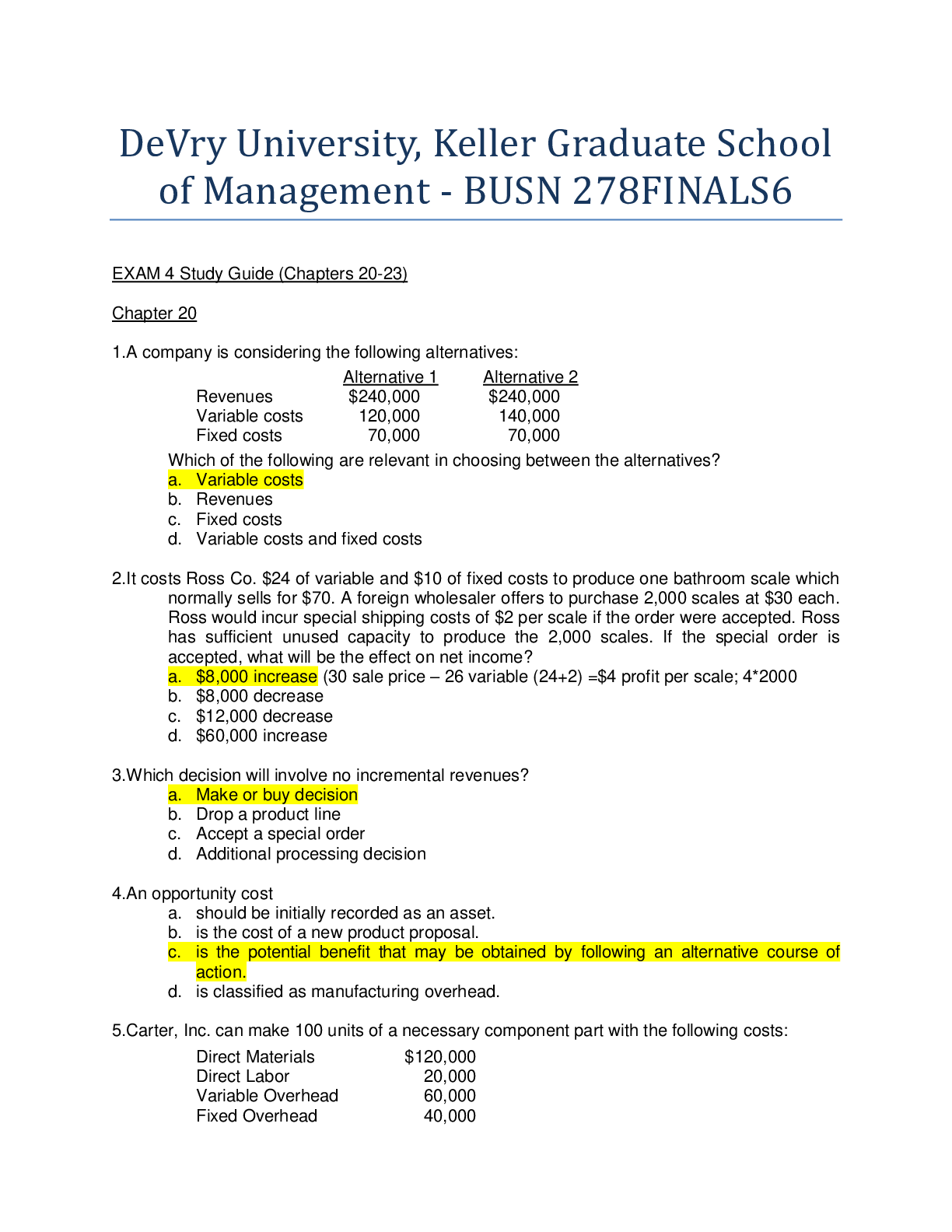
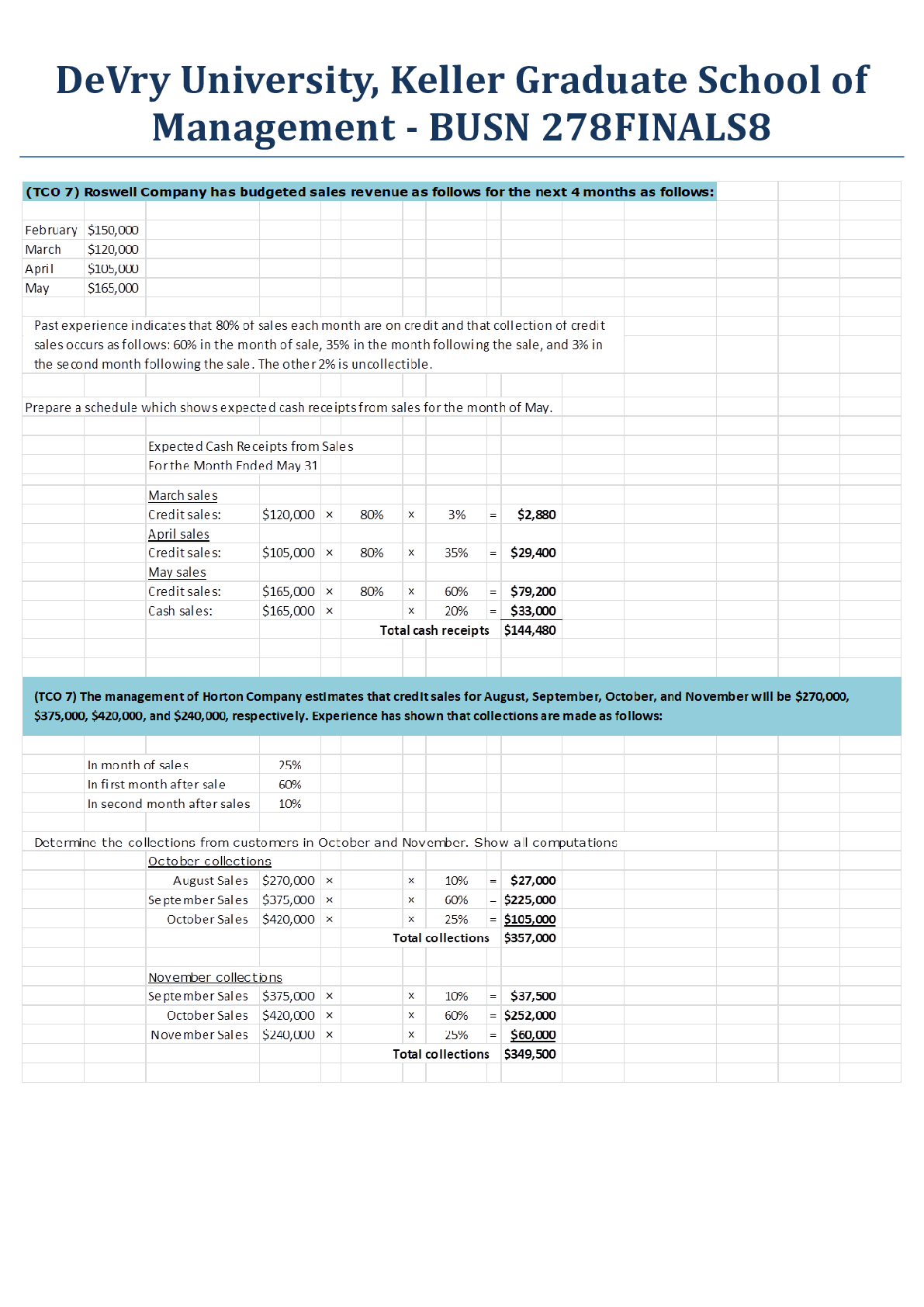

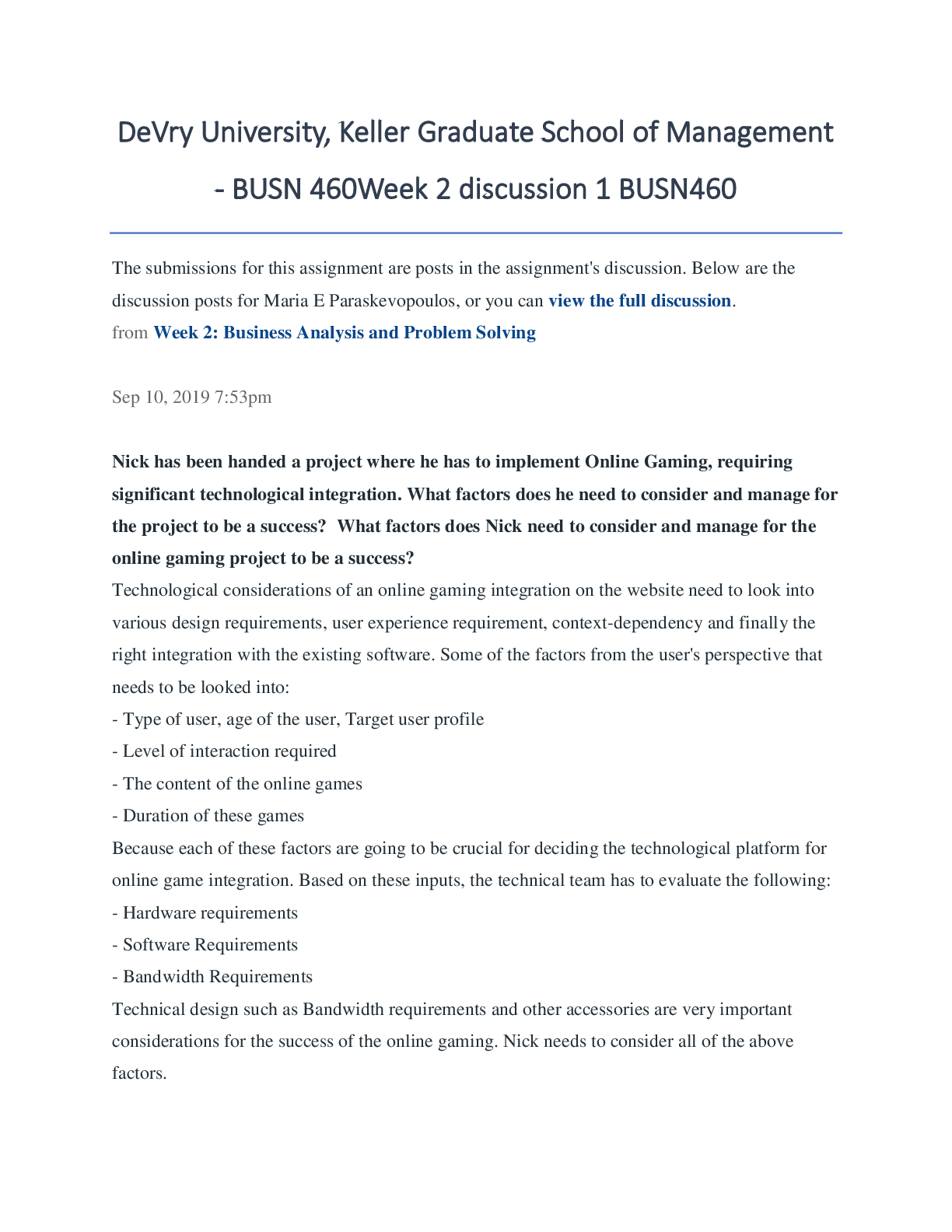
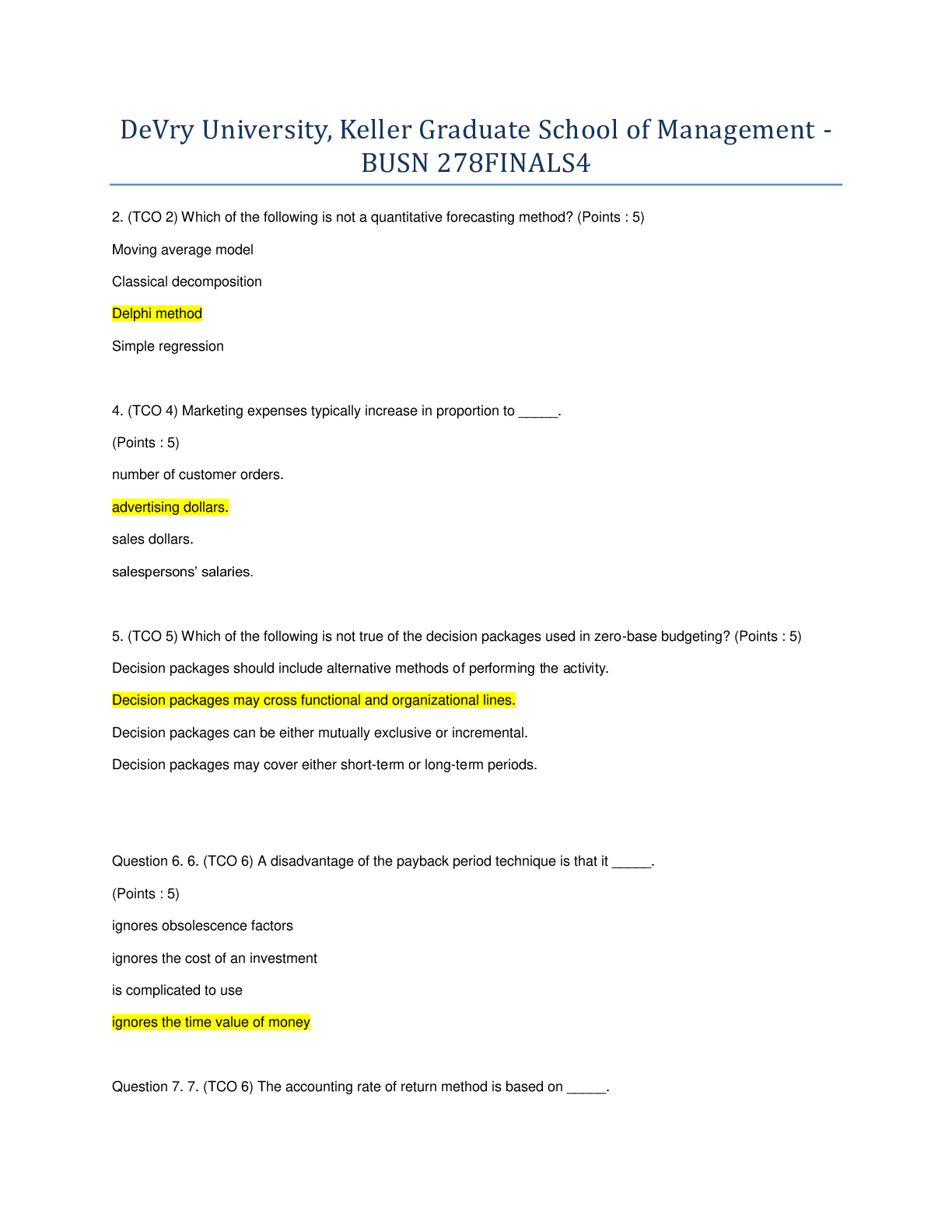
.png)
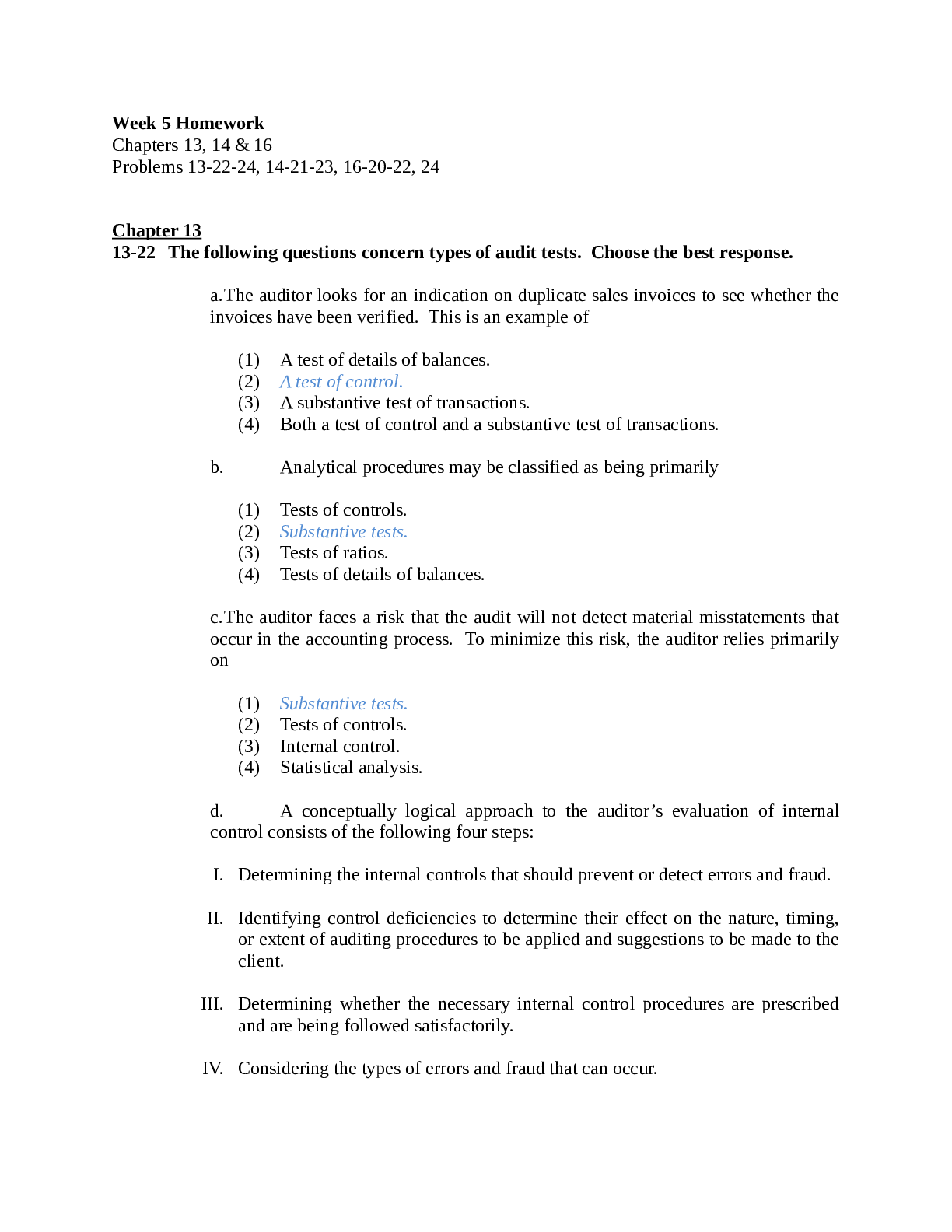
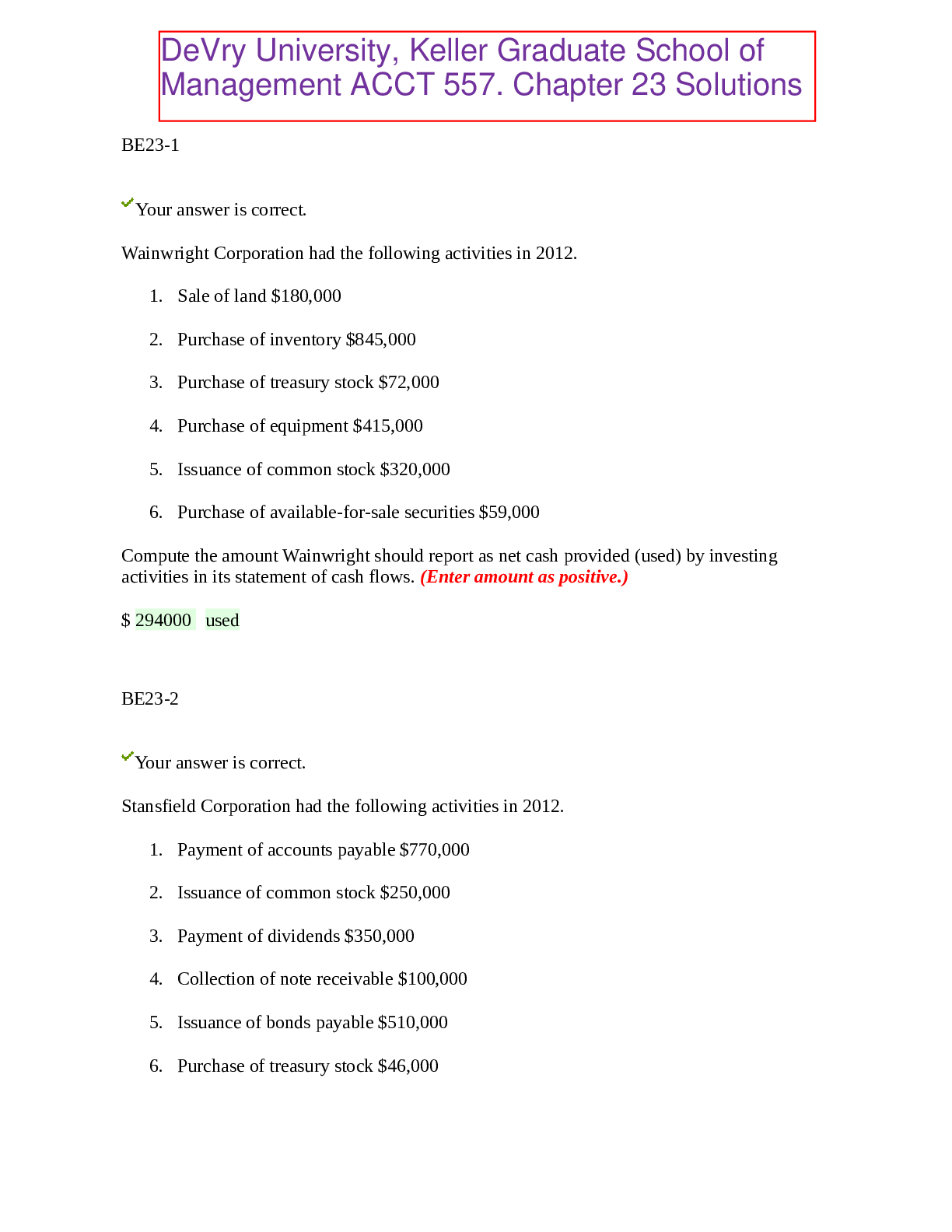
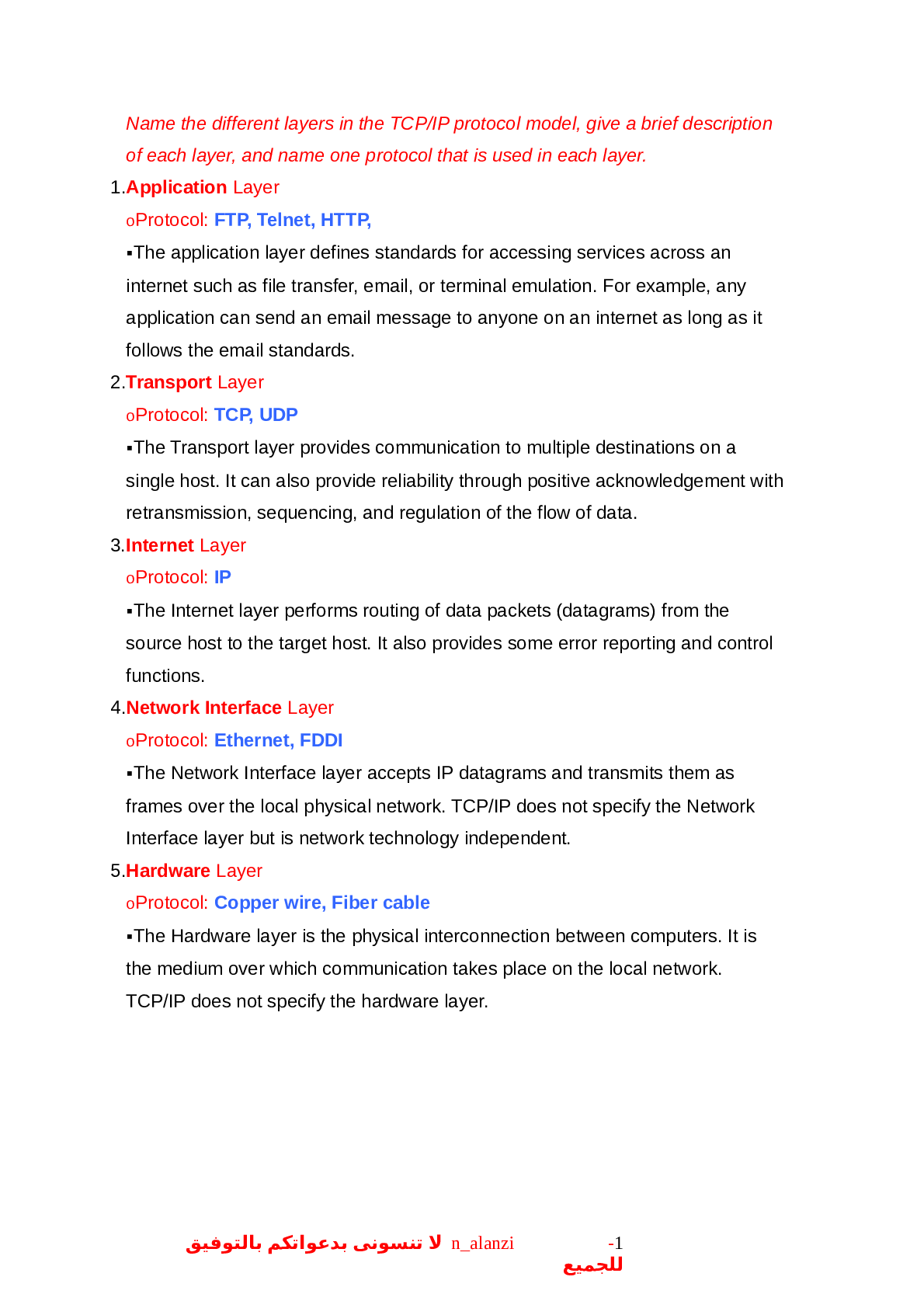
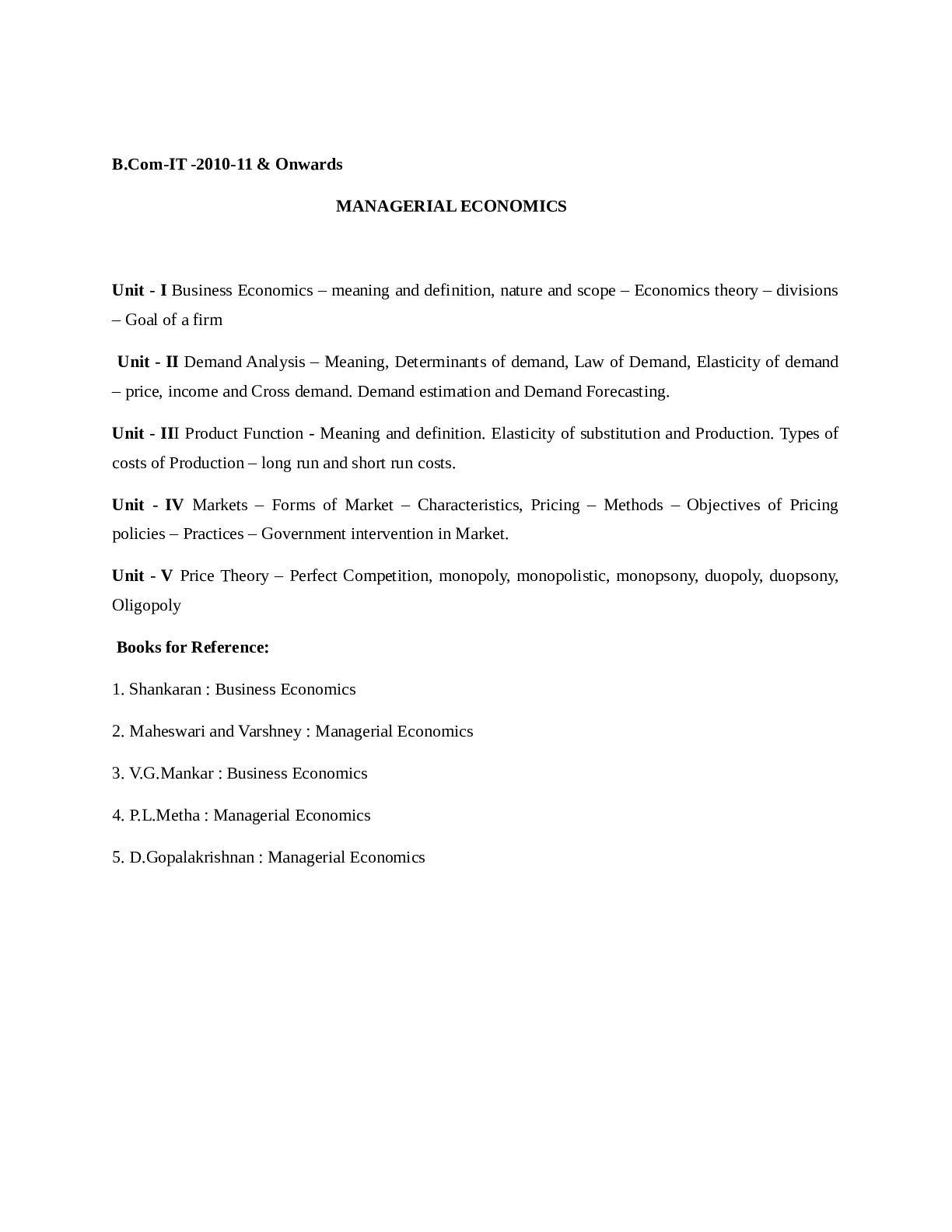
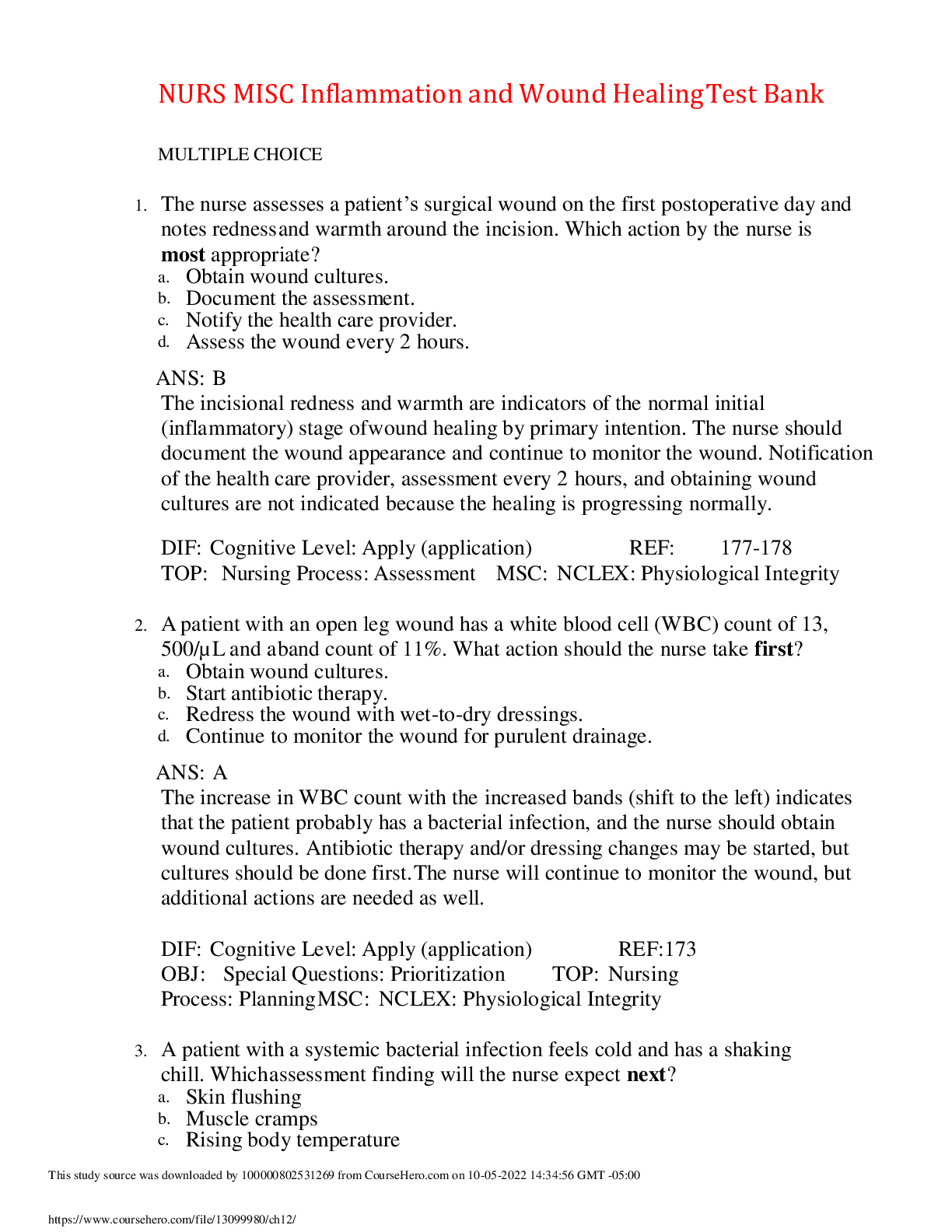

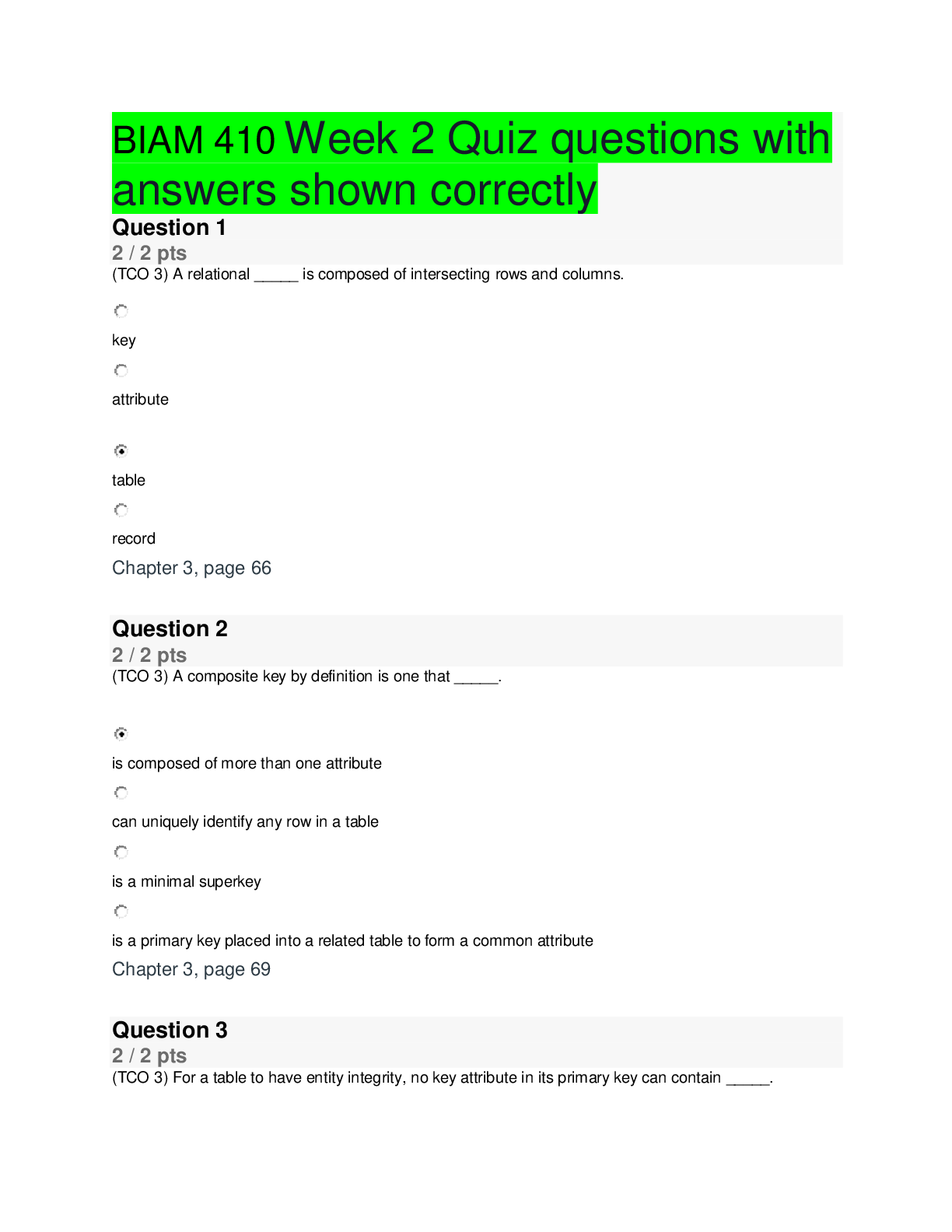
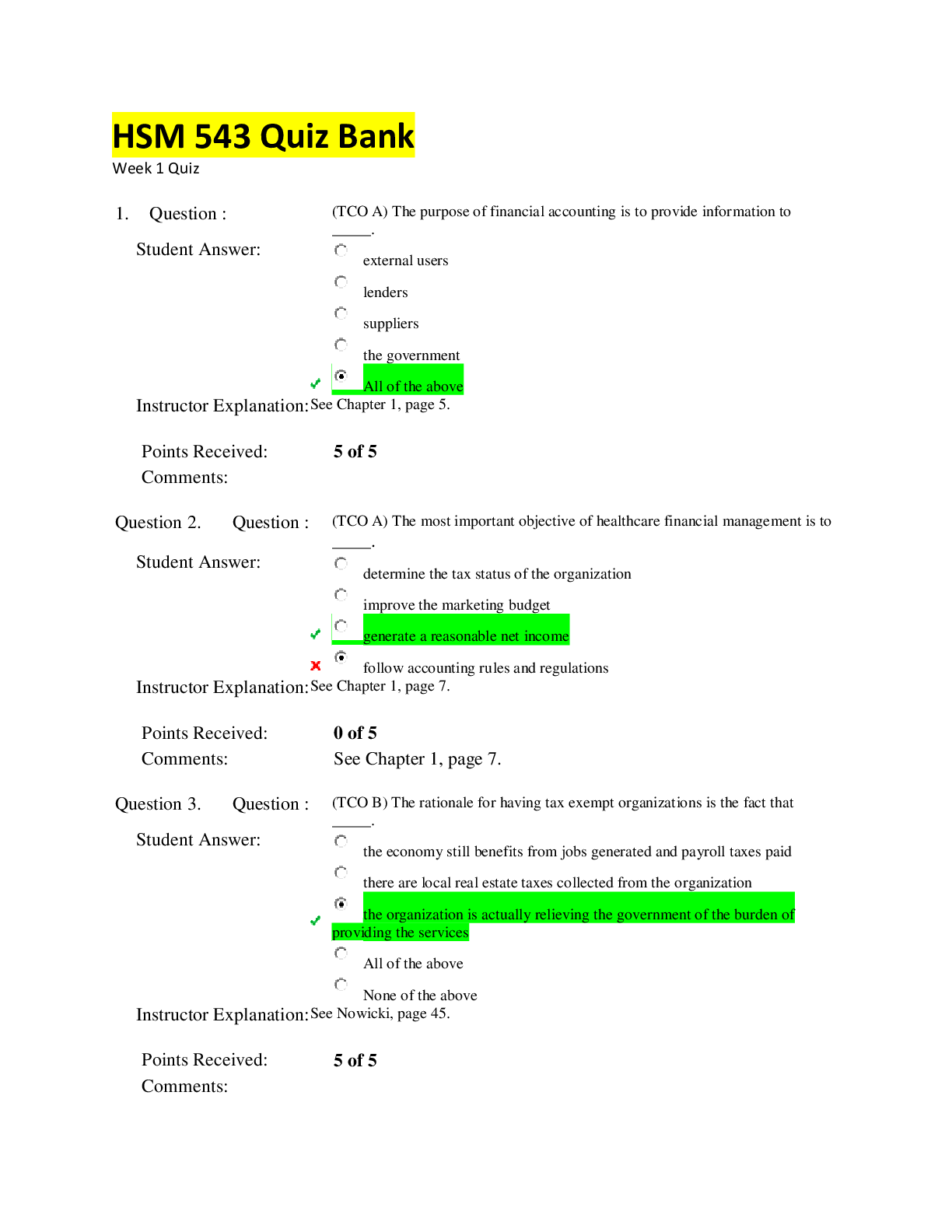
.png)

.png)
.png)

